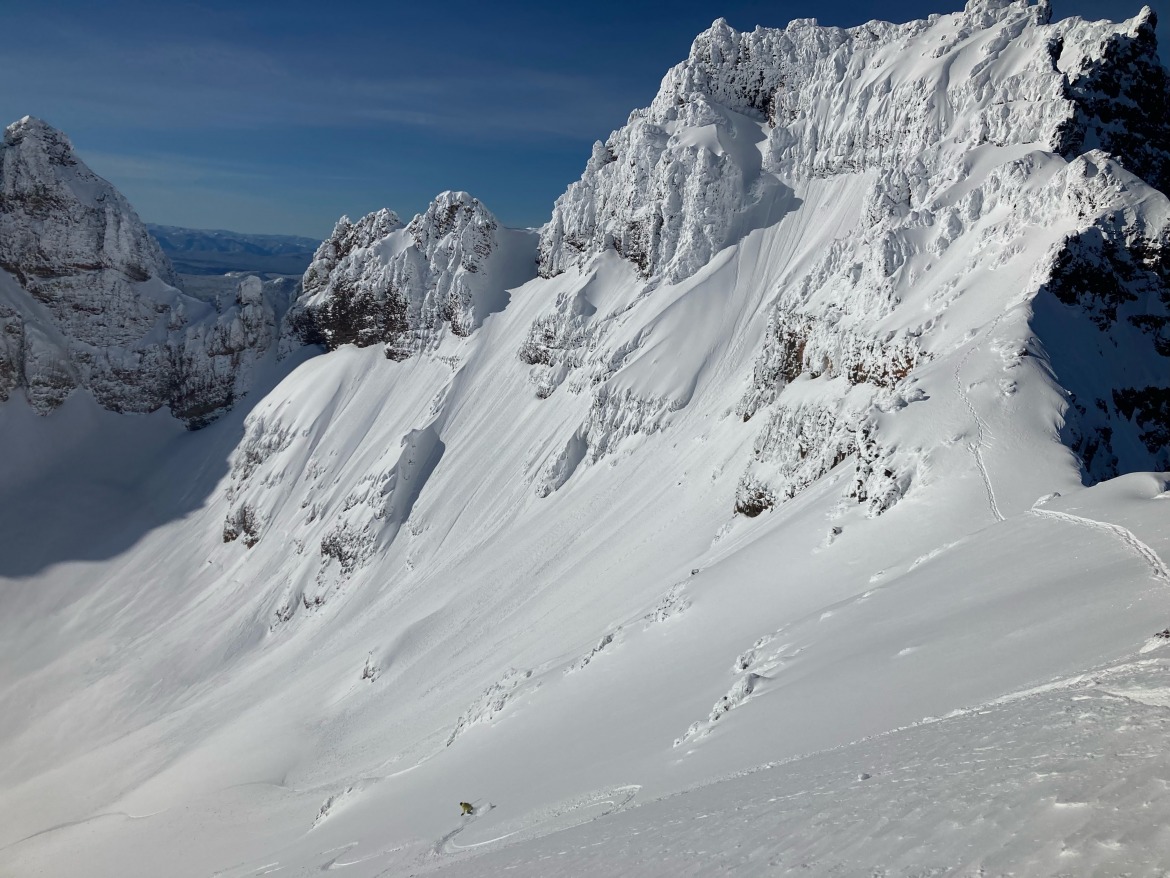
Great Backland 107 conditions: ample soft snow with a view to match this well-rounded mid-winter plank. Photo: Joe Madden.
Atomic’s Backland 107 comes into the 22/23 season with a new top sheet, otherwise the venerable ski arrives ready for mid-winter powder. Yet this is not a ski to compartmentalize as it is well suited for those variable days and the off chance you encounter firm snow in steep terrain.
I know the precise day in 2021 when I had my ah-hah. It was my son’s 18th birthday, mid-ish February. It had ceremoniously been dumping with moderate winds. It was, for a fledgling 18-year-old, a highlight day. Mostly, the snow was deep. But here and there were pockets of variable stashes, which caused me to either check speed drastically or ski with a timid (read unfun) mindset. The gear setup was off; I had swung the performance pendulum too far to the light-is-right side over the years. My skiing hesitancy that day resulted from light boots (Fischer Travers Carbons) and light skis for their width, the Movement Alp Track LT 100 (1250g/ski + 200g for the binding). The terrain, which resembles a horseshoe-shaped cirque with sustained steepish slots, begs for higher speed and unabashed bigger turns. On that day, I had neither.
Sure, the lighter setup may have matched the soft, deep pillowy snow conditions in some spots. With my timidity that day, which could have resulted in a ligament-tearing tumble, I pivoted to wanting decidedly heavier gear with more oomph to match less-than-perfect conditions.
Bigger and stiffer boots came in the form of a Fischer Transalp Pro. The wider, heavier, longer, more stable, and floatier-in-deep-and-variable-snow skis materialized in Atomic’s 2022-2023 Backland 107. This season’s Backland 107 comes unchanged from previous years, except for a new black/gray topsheet.
After emailing several folks familiar with Atomic’s ski lineup, I went longer than usual to select a 182cm; I’m 5’10”. The Movements, for reference, are 177s. In fact, 182cm is as long as I’ve skied since the days of my 210cm Kazama Outback Softs. The longer length in the Backlands bumped the turning radius from 17.5m (175cm) to 18.5m, which is to my liking. I prefer longer radius turns.
Upon delivery of the boards, I was, however, a bit unnerved at the unboxing. With my heavier boot, around 1450g/boot, there was a gut-check weighing these planks. They were 1638g and 1660g, respectively. Atomic and others have them weighed out at ~1550g-1590g. Add on just over 300g per binding, and I’d be pushing over 2kg+ / ski with skins adhered. It’s worth repeating that I was seeking burly, which in this case amounts to heavier; just not maybe pushing beyond 1600+g/ski burly.
Backland 107 Metrics
Available lengths (cm): 175, 182 (tested), 189
Dimensions: (mm) 137/107/124 (182cm)
Radius (m): 18.5m (182cm)
Mass (g): Claimed 1550g Measured at 1638g & 1660g/ski
Mount Position (cm from center): -9.0cm
Profile: Rocker-camber rocker with ample tip rocker and softish flex up front, cambered section underfoot, and a modestly rockered/flat tail with noticeable tail taper. Likes to go long with the turns.
Binding & Boot Pairing Tested: Mounted with ATK Crest 10. Tested with Fischer Trans Alp Pro boot.
MSRP: $749.99
Hear me out for a moment, even if you’re shying away from so many grams. The emotional return on investment of pushing more weight was a somewhat radical finding for me but something less revelatory for some; more joyful skiing. Part of that joy, which I’ll expand on, was that I often felt more in control and, by default, safer when throttling up the speed.
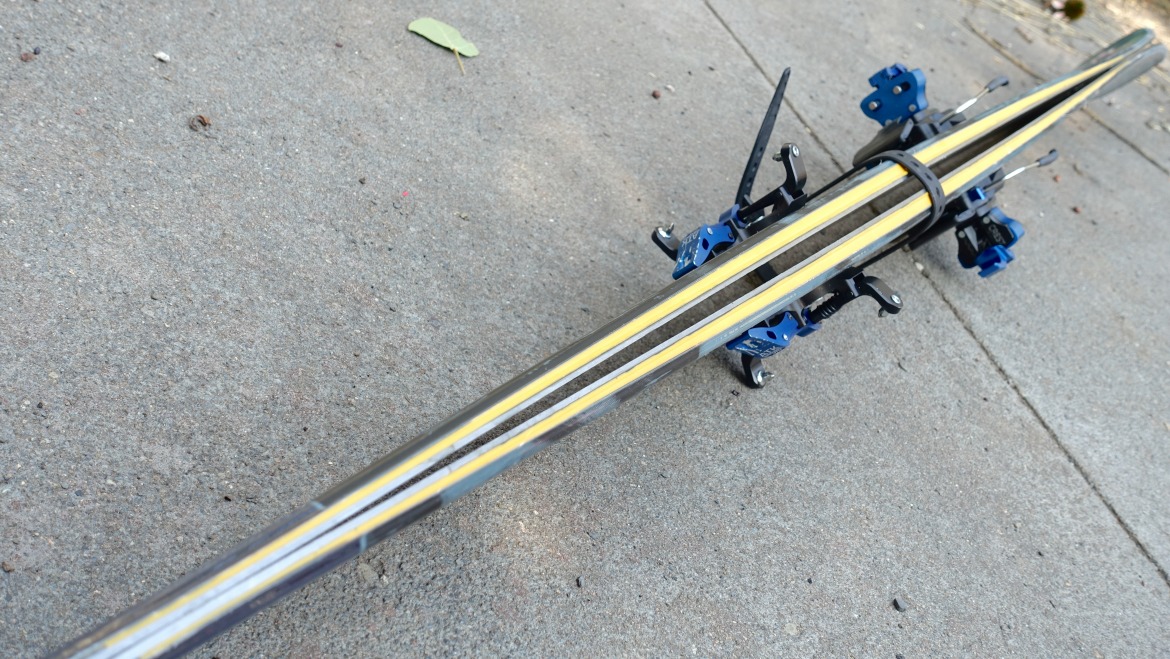
The Backland 107 has a robust build in an ~1650g ski (182cm) and features a full sidewall for better durability and a stable ride.
Some call the Backland 107 a powder charger. Yes, it is that. And some have written about skiing firm spring snow with this board, but I can think of better, lighter, and skinnier options— WildSnow’s archives are full of them. But, if you’re powder hunting and come across some boilerplate, the Backland 107s will work in a pinch. The same can be said of variable conditions too. For me, the Backland 107 is a job-specific tool in my PNW-quiver: powder 100% for sure. And for “expected” powder but likely to encounter variable snow and tracked powder, these too would be the tools of choice. Otherwise, if I’m on the Backland 107s and hit something other than that defined range, I’ve likely missed the ski selection. Luckily, conditions are somewhat predictable here.
Backland 107 Design
There’s nothing so radical in this ski. It is sensibly modern with its tip and tail rocker, camber underfoot, and a basic nod to what works below the topsheet. A Poplar and Karuba wood core is the ski’s bones, with a fiberglass weave and carbon stringers (which run the ski’s length) for added stiffness and full side walls for a solid ride and durability. The designers also include a carbon backbone insert for rigidity.
The first third of the ski’s length, which includes Atomic’s HRZN Tech tip, trends towards soft. (The tip has a cool beveled shape and has been around for several years, but does it make the ski any different? That’s hard to tell.) The flex here is not noodly, but when arcing in soft snow, you can drive from a center stance, and the tips and front end plane nicely. The ski’s mid-section is strong and presents as laterally stiff, which provides a solid and stable platform from which to drive. This rigid midsection also pays dividends in steeper and firmer snow.
The tail, or the tail-third of the ski’s length, feels more firm snow ready too; it’s stiffer than the front end and sports less rocker. If you are prone to get back on these skis, you’ll know this is not the sweet spot. Try to stay centered and drive into the tips.
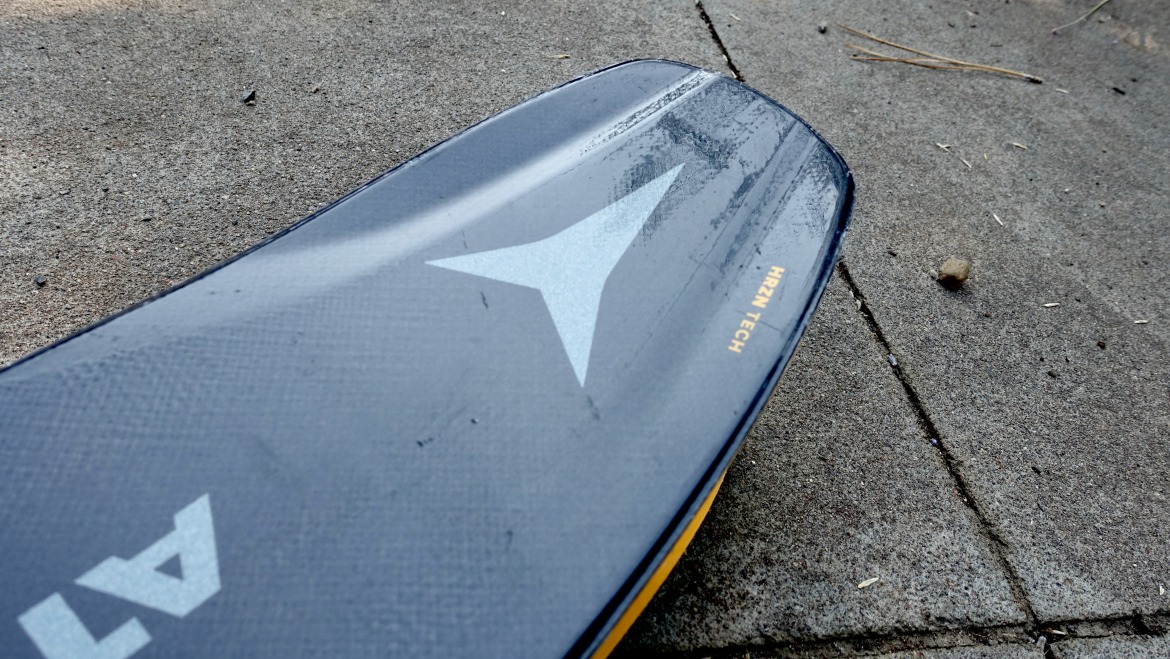
Up close and personal with the Backland 107’s HRZN Tip.
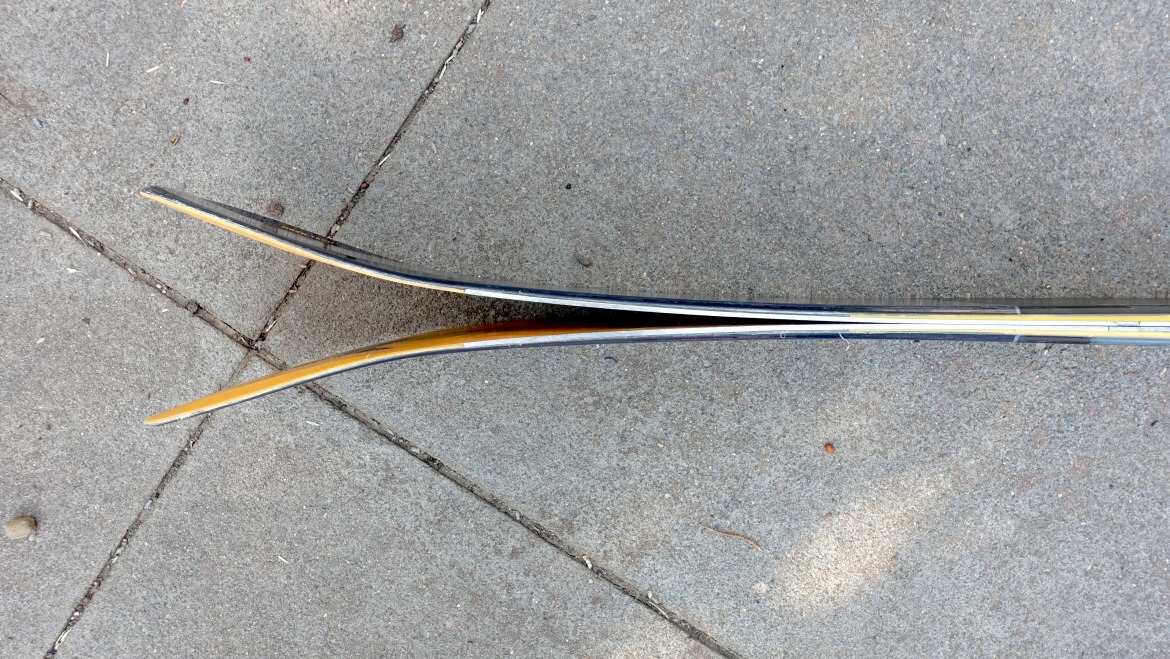
Here we see the tip splay and rocker of the Backland 107 with the skis decambered.
Tip Rocker
Think of this as primarily a traditional powder ski: a little camber underfoot, 4mm at max height, ample but not too much tip rise for my liking. The tip rocker extends from the tip back ~35.3cm until the base makes contact with the snow. The tip rises 5.2cm in total from the snow surface. There’s nothing too radical here. But the softer flex up front adds to the sense that the ski is perhaps more rockered than these metrics suggest.
Tail Rocker
The rise extends from the tail back 13.8cm until the base makes contact with the snow. The tail rises a total of 1.9cm from. It’s not a supremely flat tail, but it is flat enough and stiff enough to insert the ski tail first straight into the snow and establish an anchor or easily guy out a mid or tent fly. The rear section also feels more traditional in its stiffness and rocker profile.
Brief Comparison
Compared to other similar skis, the Black Crows Corvus Freebird is heavier (~1900+g/ski) and has less tip and tail rocker, as does the K2 Wayback 106 (this ski is slightly lighter than the Backland 107). SoothSki measures both skis as stiffer in bending and torsional stiffness than the Backland 107. On the other hand, Black Diamond’s Helio 104 is slightly softer in flex and has a similar tip and tail rocker profile.
I received the Backland 107 in early January: Sadly, we were knee deep, not in pow, but high pressure and solid snow firmness. I initially had only a few days in my desired snow type for this ski. I did score a few powder days, but they were like mid-winter sunshine in Portland, Oregon: fleeting. I resigned myself to review the ski early this season after ample time in my desired Backland 107 conditions, soft snow.
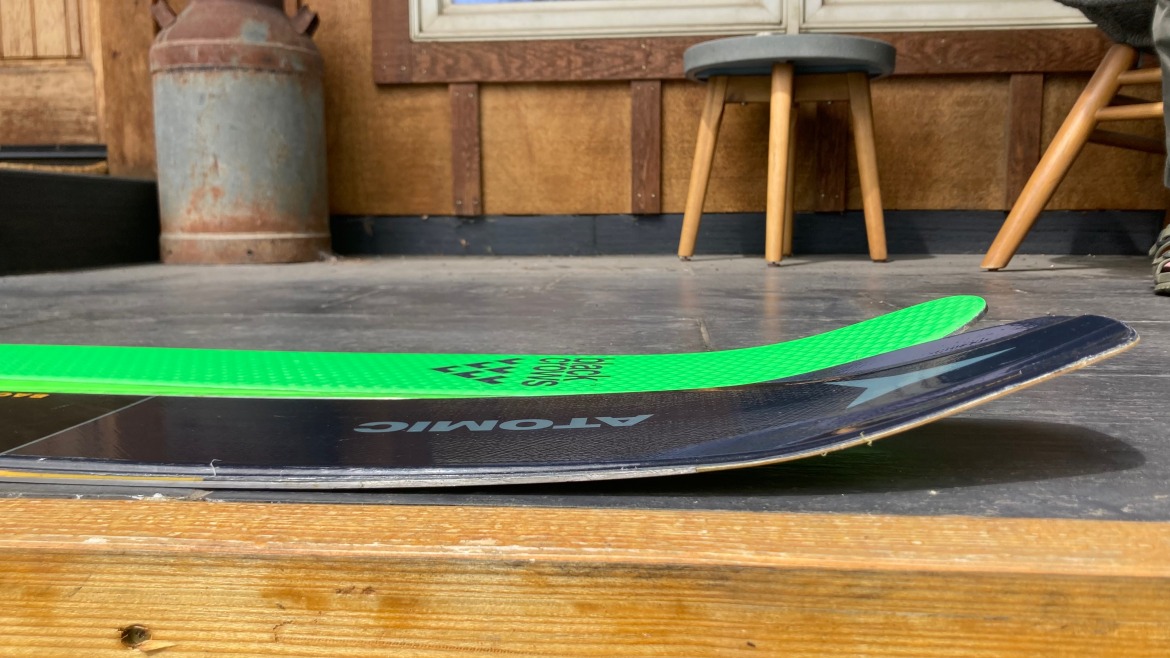
Backland 107 tip rocker (foreground) Black Crows Navis Freebird in the background.
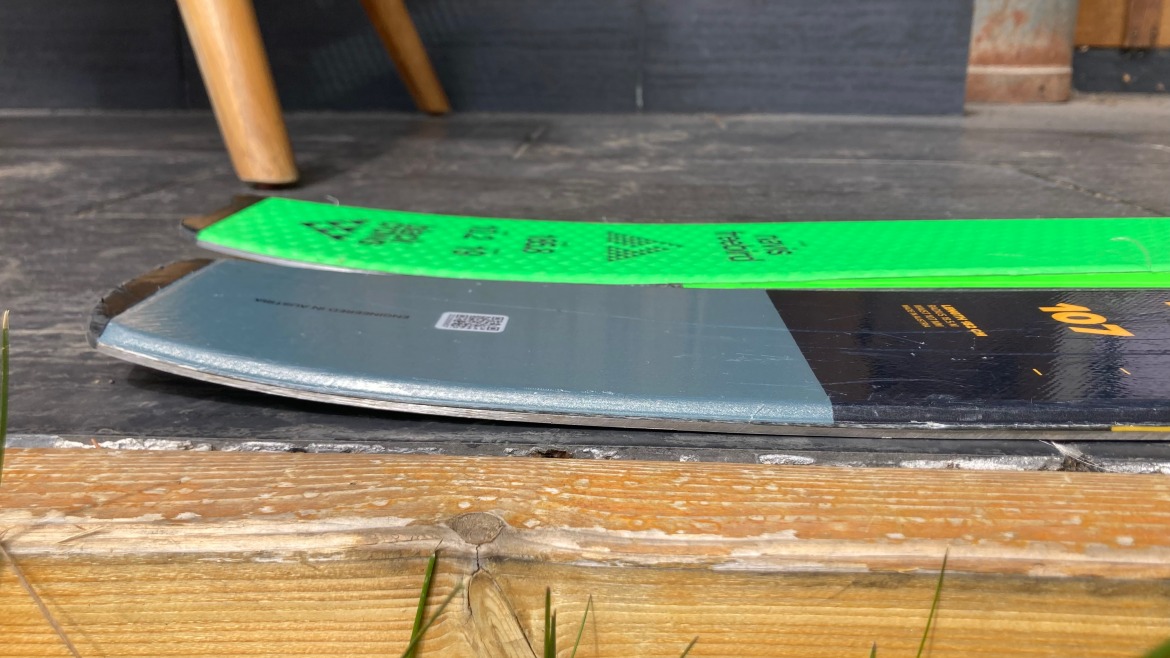
Backland 107 tail rocker (foreground) Black Crows Navis Freebird in the background.
The Backland 107 on Wind board and Ice and the Firm
Joe Madden, a local splitboarder, and I had eyes on a north/northeast facing shot on Mount Washington. Before our ski, it had snowed a bit, with prevailing winds from the SW. We reasoned we could find some softer wind deposited snow on our chosen line. We scurried along the ridge. Joe topped out first at the high point. He tapped his carbon fiber pole on couloir option one (the spicier of the ski options). The pole snapped. Too firm. We retreated to option number two; firm snow, trending towards ice there too. But this shot seemed less spooky, and we could see the entire line, yet the surface was wind scoured by the broom of the mountain gods. This was my first day on the Backland 107s. The initial 100-150meters was jump turn terrain for me. Considering what was under my feet, the butterflies fluttered. I was used to shorter, stiffer, skinnier skis in such terrain.
I slid in and began a 1-2-3 jump mantra.
The swing weight was oddly precise, and the edges held solid. That likely has to do with the relatively stiff tail, full sidewalls, carbon, and stiff mid-section. I was expecting chattery tips; they held firm. I could feel the mild tip splay up front, which was expected, but there was no hint of washout. The Backland 107 would not be my couloir-hunting firm snow ski (too long, too wide, yadda yadda). But, if, like me, you miss the mid-winter memo on where to find the good snow, the Backland 107 shouldn’t be a mortal liability in this scenario.
I got my fill that day using this wider, more rockered ski in steep terrain, and in some odd way, it all felt comforting. These do not ski like banana-shaped noodles. I was, no doubt, tense, but in hindsight, that had less to do with actual ski performance than how I expected the ski to feel in those conditions. Soothski, for example, cites the running length as ~120cm, or 67% of the ski’s length, which places it in the realm of a capable firm snow ski; this proved out on Mt. Washington.
On the wind board lower down, the ski, at non-freeski speeds, was manageable. It’s not a slalom cut on the Backland 107s. Think a duller butter knife, not a Ginsu, when arcing turns. The ski’s width saps the pizazz from the bliss of carving, but they were stable and not grabby.
The same can be said about the Backland 107s on the groomers. It’s a ski, and it slides. But you can do better on a skinnier ski that will feel more responsive. But the Backland 107 seeks not wind board, ice, or Piston Bully harassed snow on the groomers.
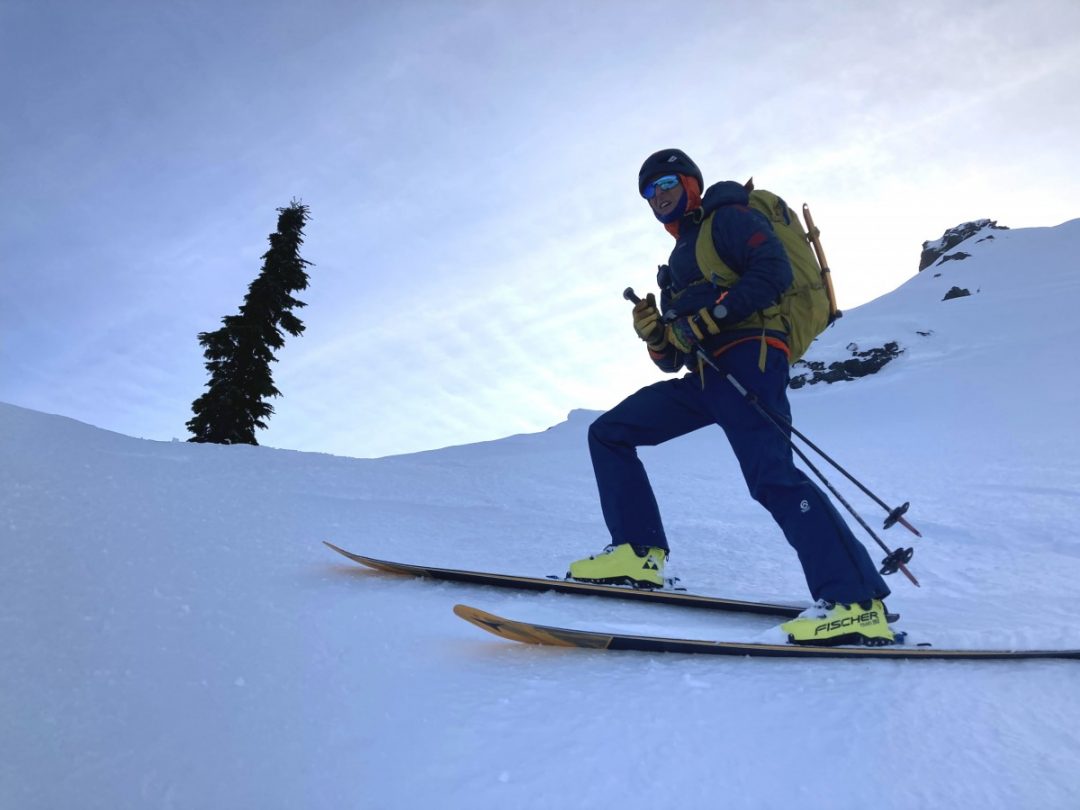
In firmer snow, the Backland 107 possessed solid edge hold and security, a big plus for a ski trending wide. Photo: Joe Madden.
The Variable
The Backland 107’s asset when the snow morphs towards crud is its surface area and softer tip. For those like me, who typically eschew “wide,” the 107mm underfoot will feel ample in the realm of crud and varieties of variable. I’m not intentionally seeking variable conditions, but, as the saying goes, variable happens. The Backland 107 platform skied admirably. The tips felt loose enough not to grab and remain near the surface. Again, with a centered stance, the tails weren’t overly grabby.
Included in variable snow, in my opinion, is tracked-out powder. While it may resemble powder, maybe two degrees separated, tracked powder presents inconsistencies in the snow surface— it skis towards the variable side of the spectrum. The Backland 107s transmit this variable less-flowy energy from the binding toe unit to the tips. At speed, meaning you are opening it up, I felt subtle thuds in the ski’s front end. I think of it like a car’s suspension— the Backland’s softer tip rides over the unsmooth surface, absorbing the mild impacts. You’ll feel the ski’s front end bear the burden here. This won’t, or shouldn’t, knock you off your feet, but I found myself the most stable with a slightly less-than-centered stance allowing the skis to run. But don’t get too far back; in this case, the stiffer tails are not the most releasable.
If we can count wind-affected powder in the variable realm, the Backland 107s were excellent. This is when you can maintain that centered stance, drive the ski, and feel confident in being in the moment. You’ll likely not get hucked over the front or back end.
Powder/Soft Snow
I recall a day, many years ago, when I skied a foot of soft snow off Galena Pass on 65mm underfoot race skis and felt all the love I’d ever need. I’ve moved on from those sentiments. More ski in soft snow is a better ski in soft snow; to a point.
The soft snow did finally arrive – in spring. I’m not romping in lake effect Wasatch snow here: but Pete Vordenberg is, and he claims a 100mm underfoot does wonders. Anyhow, why not play it safe if 100mm works in Utah, and go 7mm louder underfoot and all the way to 107? The Backland 107 offers ample girth and surface area to float, and float some more. Maybe, on the deepest of days, I’d notch up to a 189cm length, but those days are rare for anyone except maybe the lucky souls awaiting the goods in a mobile tiny-home at a sno-park near you.
As noted, centered stance skiing is rewarded with a floaty and responsive chassis underfoot and a soft but not too soft front end. This ski, in my experience, will tempt the semi-cautious skier to be more playful and lap up the freeski kool-aid. Take the ski’s lead here; the Backland 107s will hold your hand to some extent and likely make you better at painting the canvas of powder. At speed, the ski tracked great and was uber stable, but the 18.5m turn radius wants to go longer, not shorter. You’ll love this ski in widely spaced trees, in forests trending towards dog hair stands, be wary; these are not the most nimble of powder surfers compared to more banana-shaped planks.
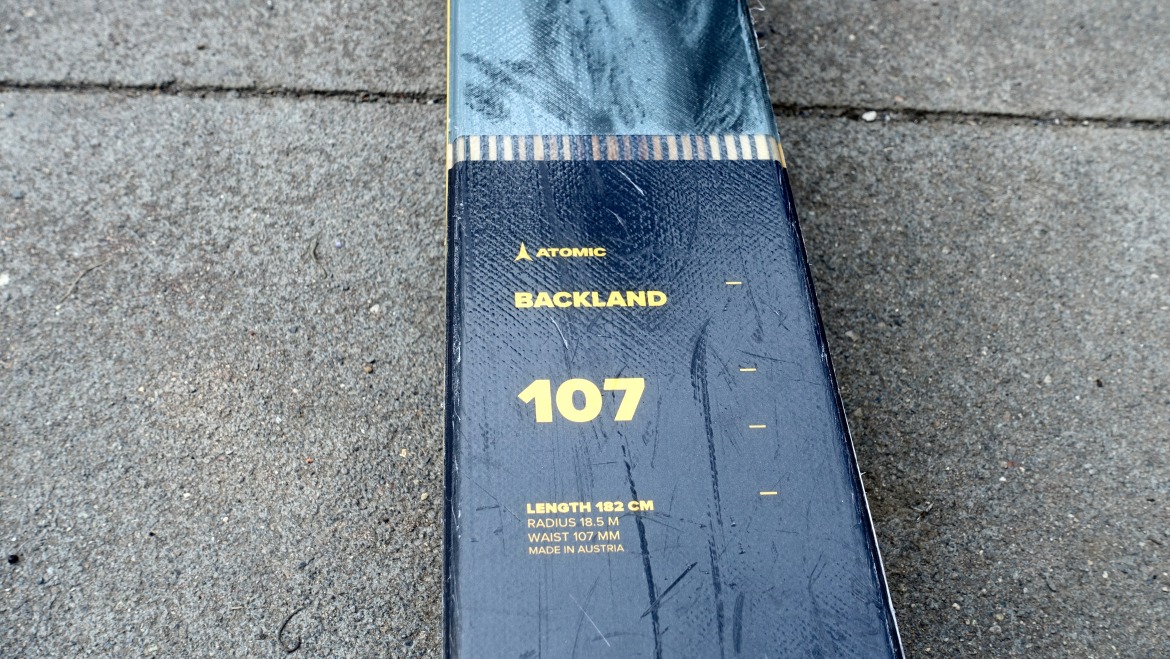
The Backland 107 has a Poplar/Karuba wood core with ample fiberglass and carbon to stiffen up the chassis for a variety of conditions.
Final Thoughts on the Backland 107
This time of year, if you plopped those old PDG race skis that killed atop Galena Pass in front of me, I might drool; it’s hot, the AQI is beyond unhealthy, and fall is teasing us. But why be teased? That’s the case with the Backland 107. This ski can be, and is, a real deal soft snow powder ski that can improve your skiing by providing plenty of float and stability at speed, and the ability, with the ample surface area and flex profile, to check that speed.
The Backland 107 remains a ski that will not be categorized as solely a ski for soft snow days. It has a broader range. And therefore, the Backland 107 can be an amazing choice for someone building out a quiver of two.
A corn ski? The Backland 107, like many planks, will do fine. But it will feel dull and heavy in spring when you should go shorter and lighter. Maybe this ski is an option for those looking for a 50/50 on/off-piste ski. I feel skis in this width, the 105mm plus realm, lack the snap and pizzazz for most on-piste skiing. The Backland 107, on groomers, was fine. But just fine. I could do better going from edge to edge in a skinnier ski with less rocker up front.
I am a convert, though. I am OK with, on some days, hauling more weight to skew the turns towards better turns. I never did pull a 10k day on the Backland 107s. But there were plenty of 5k days incurred. For someone used to 1kg class boots, 200g bindings, and 1000-1200g skis, I used the Backland 107s more often to get myself conditioned to hauling more weight. After several tours, the Backlands 107s, and the heftier boots, were welcome company. At ~1650g per ski, I’m not even thinking about a weight penalty at this point, only that if it snows five inches or more, I’m willfully grabbing the Backland 107s.
The other thing to keep in mind is cost. This sport is not cheap. Still, at $749.99, relatively speaking, that’s a reasonable amount of coin to get into a 105mm+ ski that has proven durable and stout so far.
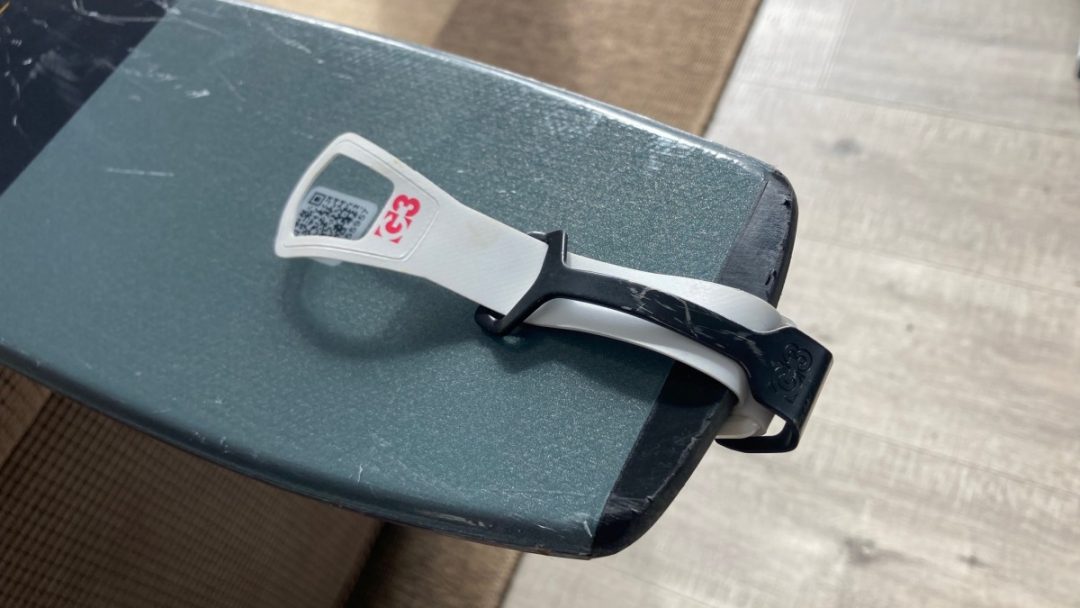
G3 skin tail affixed to the Backland 107. The fit is solid and secure.
One thing of note. The tail does include a reinforced plastic section for durability. For the life of me, I felt like the standard Pomoca tail clips would nearly snap when securing them to the thick Backland 107’s tails. (This may have been an early production issue as I received these skis last January.) I used a G3 skin most often on this ski, which has a more forgiving design to affix the tail, and had no problems. I also never had issues with the G3 tip system and soft powder snow working under the beveled edges of the HRZN Tech tip and adversely impacting skin adhesion.

The Atomic Backland 107 arrives as the well-rounded soft-snow-thrving staple we’ve come to know in the Backland lines of skis.
This is a well-rounded ski that shines in powder and convinces you, too, that you can ski with confidence when the variable conditions are served up.
Shop for the 22/23 Backland 107.
Jason Albert comes to WildSnow from Bend, Oregon. After growing up on the East Coast, he migrated from Montana to Colorado and settled in Oregon. Simple pleasures are quiet and long days touring. His gray hair might stem from his first Grand Traverse in 2000 when rented leather boots and 210cm skis were not the speed weapons he had hoped for. Jason survived the transition from free-heel kool-aid drinker to faster and lighter (think AT), and safer, are better.
